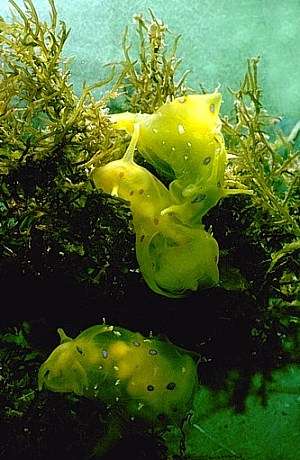
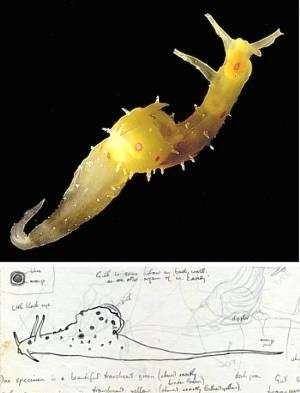
Stylocheilus longicauda
(Quoy & Gaimard, 1825)
Order: ANASPIDEA
Superfamily: APLYSIOIDEA
Family: Aplysiidae
DISTRIBUTION
Circumtropical on floating algae and flotsam.
PHOTO
Many animals washed up on algae, Kunduchi Beach, Dar es Salaam, Tanzania. Most in 35-40mm size range but some up to 60mm long. April 1976. Drawing from Tanzanian fieldnotes (January 25 1976)of another specimen showing extremely long slender tail. PHOTOS & DRAWING: Bill Rudman.
In recent years this often yellow species of Stylocheilus has been identified as Stylocheilus citrina (Rang, 1828) (Marcus, E. & Marcus, E., 1962; Marcus, E., 1972). It has a circumtropical distribution and is usually found floating in the open ocean on drifting brown algae. On two occasions I found numbers of animals washed ashore in Tanzania, on drift algae. The body ranges in colour from bright yellow to bright green with scattered ocellate spots. In specimens I have examined, the spots are usually blue, often with a reddish edge. Surrounding the spot is a clear ring then a ring of orange. In some specimens the red edge dominates and the blue spots appear red. White and blue spots without a surrounding ring can also occur. There a scattered short papillae over the body. The body is very elongate and its most characteristic feature is the extremely prolonged narrow 'tail' which can make up to half the body's total length. The sole produces a very sticky mucus. This elongation of the posterior foot, and the sticky mucus, are probably an adaptation to life on floating weed.
There is an important nomenclatural problem surrounding this species. Although the name Stylocheilus citrina Rang, refers to it, the earliest name for it must surely be Stylocheilus longicauda (Quoy & Gaimard, 1825), which is at present used incorrectly for the common species with dark longitudinal lines down the body and a relatively short 'tail'.
See separate page for discussion of the nomenclatural problems
See separate page for relevant references.
See Stylocheilus striatus
Rudman, W.B., 1999 (August 5) Stylocheilus longicauda (Quoy & Gaimard, 1825). [In] Sea Slug Forum. Australian Museum, Sydney. Available from http://www.seaslugforum.net/find/stylcaud
Related messages
Re: Stylocheilus longicauda and eggs [2]
November 19, 2009
From: Denis Riek
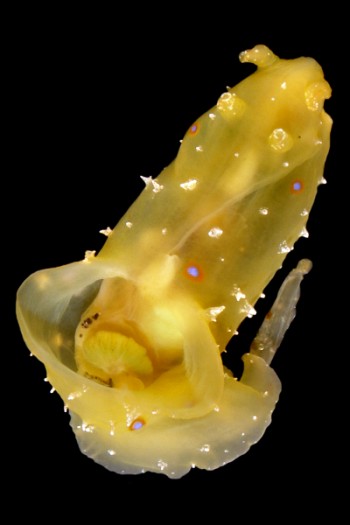
Concerning message #22809:
Hi Bill
Here are a couple more images, to accompany my previous message on Stylocheilus longicauda, showing the gill structure in detail.
Locality: Brunswick Heads, Flotsam, Northern New South Wales, Pacific, 27 October 2009, Stranded on beach. Length: 40 mm. Photographer: Denis Riek.
Cheers
Denis
dwriek@optusnet.com.au
Riek, D.W., 2009 (Nov 19) Re: Stylocheilus longicauda and eggs [2]. [Message in] Sea Slug Forum. Australian Museum, Sydney. Available from http://www.seaslugforum.net/find/22810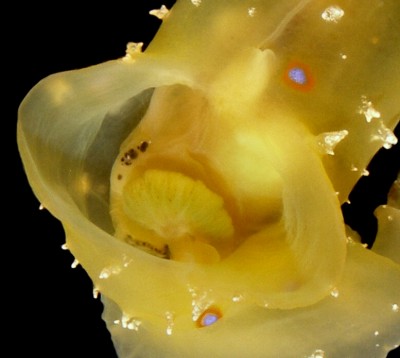
Thanks Denis,
As you can see on the Sea Hare mantle cavity page, the mantle/parapodial cavity arrangement in Stylocheilus is about halfway between the Aplysia/Syphonota arrangement where the parapodia are open flaps and Dolabella, where the parapodia are completely fused except for the inhalent and exhalent siphons. Also have a look at my drawing of Stylocheilus striatus [#7872]. Species of Stylocheilus have lost their shell so the gill is completely exposed within the parapodial cavity.
We can see a whitish line running up the body from the rim of the parapodial cavity. This is the external sperm groove which carries the animal's sperm from the common genital opening [= swelling at anterior lip of the parapodial cavity] to the penis which lies internally on the right side of the head.
Thanks for these nice photos
Best wishes,
Bill Rudman
Re: Stylocheilus longicauda and eggs [1]
November 19, 2009
From: Denis Riek
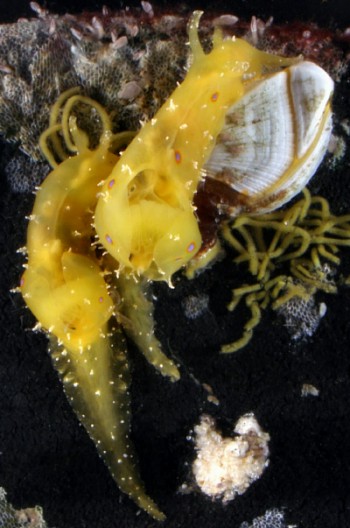
Concerning message #14066:
Hi Bill,
Here are some images of a pair of Stylocheilus longicauda found on a rubber sandal, cast up onto Brunswick Heads beach, Northern New South Wales. Goose neck barnacles, bryozoans and patches of very short, green leafy algae were on the sandal. The obvious egg coils were the first thing I spotted and a closer inspection revealed the two slugs.
On observing the animals when placed back into water they exhibited the same behaviour that Mike Greenemeier reported. Bending in all directions while standing on their tail and feeding on the green algae on the surface of the sandal.
Locality: Brunswick Heads, Flotsam, Northern New South Wales, Pacific, 27 October 2009, Stranded on beach. Length: 40mm. Photographer: Denis Riek.
Cheers
Denis
dwriek@optusnet.com.au
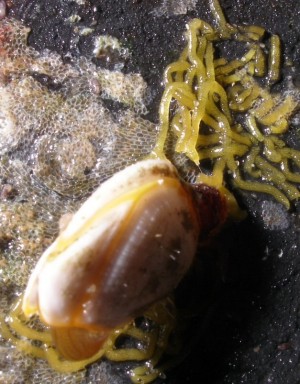
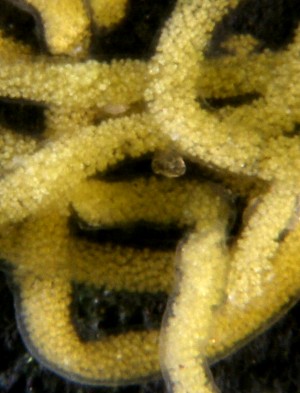

Dear Denis,
You seem to have a special skill at finding this interesting and rarely reported sea hare. These animals are certainly much more mature than those in your earlier message [#22615] and I have no doubt that the egg strings belong to them.
Best wishes,
Bill Rudman
Re: The real Stylocheilus longicauda from eastern Atlantic
August 26, 2009
From: Denis Riek
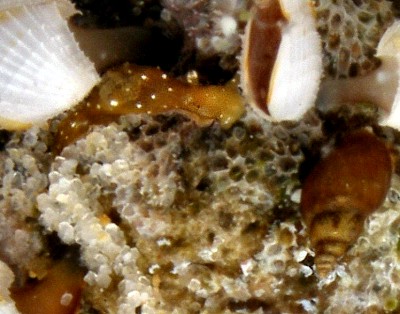
Concerning message #22607:
Hi Bill,
I don't know if this little sea hare is Stylocheilus longicauda but it does appear similar with the long tail and white spots. It was also attached to this piece of pumice (5cm dia.) with a very thin but strong mucus thread, strong enough to hold it "on board" through the surf and onto the beach. Luckily I was there as it came ashore as stranded animals have a very short life expectancy!
According to Dr Alex Cook at Queensland Museum this pumice, found in May 2008, was from the August 2006 eruption of the Home Reef Volcano, SW of Vavau, Tonga. Quite a voyage!! It also supported Bryozoans, Algae, Goose Neck Barnacles, Polychaete worms and Snails. Sorry the images aren't clearer but this slug was very small.
Locality: Hastings Point Beach, Beached, NSW Australia, Pacific, 23 March 2008. Length: 3-4mm. Photographer: Denis Riek.
Cheers
Denis
dwriek@optusnet.com.au
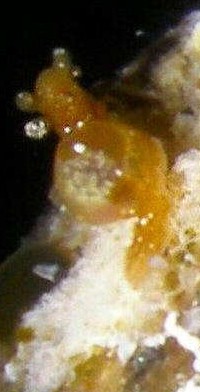


Dear Denis,
From your description of the long tail and sticky mucus, and the general colour and shape, I agree with your identification. Small aplysiids are difficult to identify but if it were a species of the genus Aplysia I would expect to see a relatively large external shell in such a juvenile. Your animal already has the elongate shape of Stylocheilus. It is fascinating how species from quite unrelated groups have adapted for this fairly perilous lifestyle of living on floating debris. Others that come to mind are the aeolid Fiona pinnata and the dorid Vayssierea felis.
It is a nice find.
Best wishes,
Bill Rudman
The real Stylocheilus longicauda from eastern Atlantic
August 20, 2009
From: Peter Wirtz

Hi Bill,
Here is a Stylocheilus longicauda from a floating rope at Madeira Island. You write that it is circumtropical but are there really records from the EASTERN Atlantic (that do not refer to S. striatus) ?
Cheers,
Peter
Prof. Dr. Peter Wirtz
Madeira
Portugal
peterwirtz2004@yahoo.com
Wirtz, P., 2009 (Aug 20) The real Stylocheilus longicauda from eastern Atlantic. [Message in] Sea Slug Forum. Australian Museum, Sydney. Available from http://www.seaslugforum.net/find/22607
Hi Peter,
Rang's illustration of Aplysia citrina, which looks very like your photo, was from the "equatorial mid-Atlantic on floating Fucus" [see separate discussion]. I think that's the nearest find to the eastern Atlantic - but it may be worth checking Engel's paper which I don't have a copy of at home.
As this species is seldom reported, it is good to get another record - and one that certainly gets us closer to the eastern side of the Atlantic.
-
Rang, S., (1828) Histoire Naturelle des Aplysiens. 83pp. Paris: Imprimerie Firmin Didot.
-
Engel, H. (1930): Aclesia citrina (Rang), eine zirkumtropische Aplysiide. Zoologischer Anzeiger 86(7/8): 211-219.
Best wishes,
Bill Rudman
Sea hares on floating pumice
December 30, 2006
From: Kathe R. Jensen
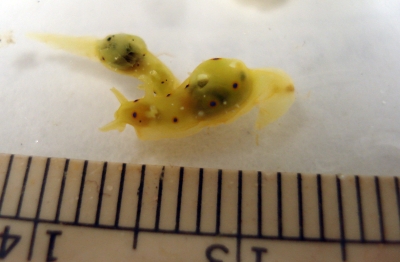
Dear Bill,
I realize that this message will not get on the forum till after New Years. However, we are getting off the Galathea 3 ship tomorrow morning, and I am not sure what internet connections will be like in Gizo, Solomon Islands.
A couple of days ago, while we were hauling in long-lines, we noticed patches of brown material floating on the surface. At first we thought it was Sargassum weed or something like that. So we sent out a zodiac to pick up some, and it turned out to be floating pumice rubble, most of which was covered in gooseneck barnacles. I set out looking for Fiona, but to my surprise found little yellow sea hares, which turned out to be Stylocheilus longicauda (or citrina?). Most of them were about 10-20 mm long, and I collected at least 20 specimens from a 10 liter bucket.
Locality: Coral Sea, surface, South Pacific, 22 December 2006, from floating pumice. Length: about 10-15 mm. Photographer: Kathe Jensen.
Happy New Year to everyone,
Kathe
krjensen@snm.ku.dk
Jensen, K.R., 2006 (Dec 30) Sea hares on floating pumice. [Message in] Sea Slug Forum. Australian Museum, Sydney. Available from http://www.seaslugforum.net/find/19091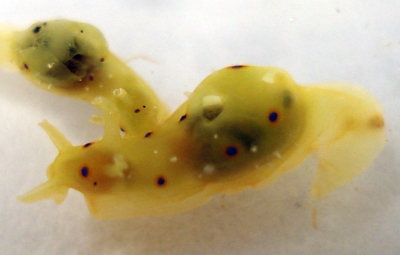
Dear Kathe,
I wasn't planning to post any more messages until the New Year but your interesting message and New Year's have made me change my mind.
This is indeed Stylocheilus longicauda. As I explained when sorting out the name of this animal [see S. longicauda & S. citrina - nomenclatural discussion] Rang's S. citrina from the Atlantic is identical to Quoy & Gaimard's S. longicauda from 'off New Guinea'. To add to the confusion, the name Stylocheilus longicauda was for many years applied to the benthic species Stylocheilus striatus. As your specimens show, S. longicauda is usually found in the open sea attached to floating brown algae, or in your case volcanic pumice. The name longicauda [= longtail] is very appropriate, as it refers to an adaptation this species has evolved to remain attached to its floating 'home' - the posterior end of the foot can extend into a long ribbon-like 'tail' which exudes a very sticky mucus.
Good Luck with the rest of your expedition
Best wishes,
Bill Rudman
The real Stylocheilus longicauda from Rarotonga
May 24, 2006
From: Graham McDonald
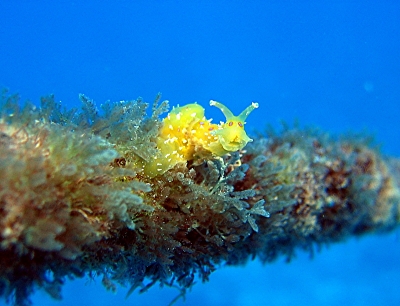
Kia orana Bill, greetings from Rarotonga.
I am going through photos that I have taken over the last 10 years to add to the Cook Islands biodiversity database. I cannot find any reference to this slug that lived with several others on a mooring line at one of our divesites.
Locality: Ngatangiia, 2 to 5metres, Rarotonga, Cook Islands, South Pacific, 02 Nvember 2003, Mooring line. Length: 10 mm. Photographer: Graham McDonald.
Regards,
Graham
images@waterworx.co.ck
McDonald, G, 2006 (May 24) The real Stylocheilus longicauda from Rarotonga. [Message in] Sea Slug Forum. Australian Museum, Sydney. Available from http://www.seaslugforum.net/find/16679
Dear Graham,
This is an interesting find. It is a small Sea Hare which seems to live on floating algae throughout the Indo-West Pacific. I guess a mooring line is a similar habitat. It had a complicated nomenclatural history which I have discussed on a separate Fact Sheet. Its name is Stylocheilus longicauda and the name longicauda [=long tail] refers to the long slender, almost ribbon-like, posterior tip of its foot which from my experience allows it to remain attached to its algal 'home' even in strong currents. Unfortunately the name Stylocheilus longicauda began to be used for the more common Stylocheilus striatus, mainly because most people thought there was only one species of Stylocheilus, and Stylocheilus longicauda was the oldest name. So its good to get another record of the 'true' Stylocheilus longicauda just to reinforce its difference from the common S. striatus.
If you have photos of other opisthobranchs from Rarotonga, even ones you can easily identify, I would welcome them on the Forum as we have few records of any opisthobranchs from that part of the Pacific
Best wishes,
Bill Rudman
Stylocheilus longicauda and eggs(?)
June 16, 2005
From: Mike Greenemeier
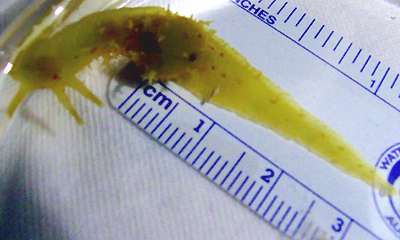
Here are a few pics of the two Stylocheilus longicauda I collected on a peice of floating plastic in Lanikai, O'ahu. When I first found them they seemed to be mating, and within a day and a half the larger one produced this string of what I believe are eggs on the underside of a powerhead nozzle. Later that day they mated again and the larger one produced another, smaller of these strings on the underside of a rock.
Also, I've made a few observations on some subjects you've mentioned in previous threads on this species.
I believe you mentioned that the long tail may be lost as the slug matures. I realize size may not be a good indicator of age or maturity, but the smaller of the two (about 1/3 the size of the large one)seems to have a much shorter tail in relation to body size. As you can tell from the picture, the tail on the larger one is about the length of the rest of the body.
You also mentioned that the tail is probably used to anchor the slug to the seaweed. I've noticed that the slug will attach the tail and the entire back half of the foot to the substrate, leaving the front half of the body unattached to swing in an arc. It will even fold in half and feed directly next to its own tail.
Mike Greenemeier
greenm3@auburn.edu
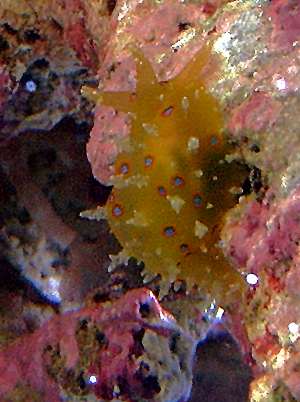
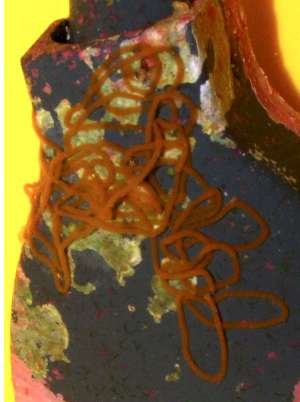
Dear Mike,
Thanks for these photos and observations on the rarely observed species of Sea Hare. I am sure the long sticky tail is an adaptation for its lifestyle, living on floating brown algae and other flotsam in the open ocean
Best wishes,
Bill Rudman
Stylocheilus longicauda from India
October 3, 2002
From: Barbara Gibson
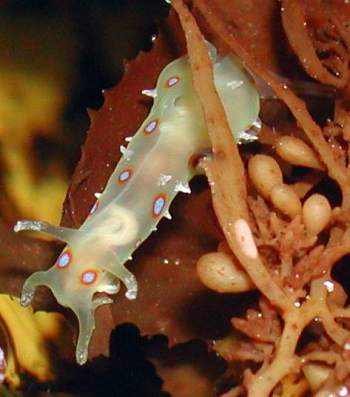
Dear Dr. Rudman,
Would you please help us, the teachers and students of the Sri Aurobindo International Center of Education, Aquarium section, to identify this beautiful little sea slug. It was captured in the brown sea weed at the shore line on the last week of August 20O2. Along the Pondicherry coast, Bay of Bengal, India. Any information that you could give us on it would be greatly appreciated. Can you also tell us what that white half moon is inside its body?
The photo was taken by a former student, Filidauro Schiavina Lemaire.
Thank you,
Barbara Gibson
barbarag@satyam.net.in
Gibson, B., 2002 (Oct 3) Stylocheilus longicauda from India. [Message in] Sea Slug Forum. Australian Museum, Sydney. Available from http://www.seaslugforum.net/find/8106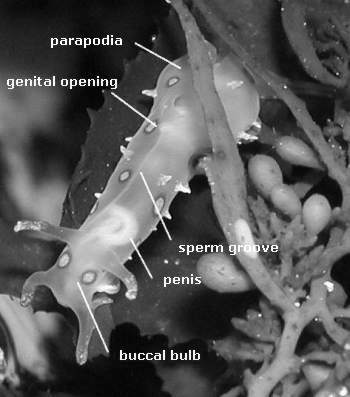
Dear Barbara,
This is an interesting Sea Hare called Stylocheilus longicauda. It has a relative, Stylocheilus striatus, which is often found throughout the tropics, in huge numbers, on sand or mud, feeding on an organic layer on the surface. On the other hand, the beautiful Stylocheilus longicauda has only been reported a few times since its discovery 175 years ago. By few, I mean less than 10 times. In most cases it was found on brown sea weed, often washed up on the beach, which suggests it spends its life on floating algae in the open ocean.
The white halfmoon structure inside its body is part of the penis. Sea Hares, like all sea slugs are hermaphrodite with fully functional male and female reproductive systems. In Sea Hares the penis, which sits retracted in the body cavity when not in use, opens on the right side of head. The 'female' parts of the reproductive system lie further back in the body cavity, and there is a genital opening at the anterior end of the mantle cavity, where the parapodial flaps meet. This genital opening has three functions - during mating the partner's penis is inserted here and during egg laying the egg string is extruded through this opening. Thirdly the animal's sperm is also extruded here and travels down an external sperm grrove to the penis. I have labelled various parts in the photo alongside to help you understand its basic anatomy. I have also labelled the 'buccal bulb' which is its feeding organ, and contains the radula, a tongue-like structure covered in rows of microscopic teeth.
Have a look at the Sea Hares Page and the Stylocheilus striatus page for further general information. You will also find more information if you scroll downn the other messages on each page.
Best wishes,
Bill Rudman
Stylocheilus longicauda from Hawaii
August 10, 1999
From: Erwin Koehler
Bill,
Your photos of the "real" Stylocheilus longicauda reminds me of an unidentified Aplysiid on the web, an excellent photo from Hawaii of Mike Severns at http://severns.maui.hi.us/pt_seahare.html
Is this the same one?
Erwin
Medslugs.Koehler@t-online.de
Koehler, E., 1999 (Aug 10) Stylocheilus longicauda from Hawaii. [Message in] Sea Slug Forum. Australian Museum, Sydney. Available from http://www.seaslugforum.net/find/1176Thanks Erwin,
Yes it's S. longicauda.
Bill Rudman.
True Stylocheilus longicauda from Caribbean
August 6, 1999
From: Betsey Hansen

Bill,
I finally got my slide scanner working. To start off, I am sending you a slide of my very first Nudibranch. This picture was taken in 1992 in Bonaire in the Caribbean. It got me started on my quest for nudibranchs. I have never been able to identify the type. What ever assistance you can provide will be greatly appreciated.
Best regards,
Betsey
Elizabeth.P.Hansen@chase.com
Hansen, E.P., 1999 (Aug 6) True Stylocheilus longicauda from Caribbean. [Message in] Sea Slug Forum. Australian Museum, Sydney. Available from http://www.seaslugforum.net/find/1131Dear Betsey,
I'm afraid your first nudibranch wasn't a nudibranch at all!. It is a Sea Hare. Both Sea Hares and nudibranchs are Sea Slugs (Opisthobranchs). If you look at the General Topics List the many entries on Sea Hares should give you some background information on the group.
Your animal is very interesting. It has, since 1828, been known as Stylocheilus citrina, but I am afraid that that is incorrect. Earlier this year Clay Carlson and I, among other things, were discussing the real identity of the common lined Stylocheilus which has usually been called Stylocheilus longicauda. We both agreed that this was incorrect but with many other things to do decided to put the problem in the 'not very urgent' pile.
However your photograph meant I have been forced to do something. While I could privately ignore the problem, once your photo arrived I was not happy with having to continue the charade that this yellow animal was Stylocheilus citrina, when I knew it really was the true Stylocheilus longicauda. So thank you for providing the catalyst for me to address the problem. Have a look at the Top of this Page and at my separate message on the Stylocheilus problem.
I must say all your photos are proving very interesting subjects.
Best wishes,
Bill Rudman.
